Copyright: Original copyright © 1986. Reformatted in 2013. No changes made to text.
Publication History: Originally published in the Outdoor Program Manual by Ron Watters, Idaho State University Press, Pocatello, 1986. pp. 1-9. This version appeared in Proceedings of the 1984 Conference on Outdoor Recreation: A Landmark Conference in the Outdoor Recreation Field, John C. Miles and Ron Watters (Eds.), Idaho State University Press, Pocatello, pp. 103-114.
Reproduction Information: you are welcome to provide links to this page or to use short quotations and paraphrases in other documents as long as they appropriately reference the source. There is no charge for non-profit organizations to reproduce or publish extensive parts or all of this paper, but please obtain advanced permission from Ron Watters (wattron@isu.edu). Photo credits: Ron Watters.
Photo credits: The photo of Gary Grimm is by Harrison "H" Hilbert. The back cover of Sam McKinney's book, Sailing Uphill, is reproduced which includes his photo. The Outward Bound emblem is a registered trademark. Abstract
To understand the changes that have occurred through the years with respect to outdoor recreation programming, it is helpful to go back in American history. Current day thought on outdoor recreation has its roots in western expansionism and settling of the frontier. The American frontier presented a formidable challenge to the early settlers who attempted to clear lands and forge a living. The imposing hardships of untamed country, climate, and illness took a heavy toll. Those who weren't strong individuals either hardened to the demands or perished.
It was this breed of "rugged individuals" and their sense of pride as the land was cultivated and towns and cities grew out of the wilderness, which provided the growing nation with a source of national character and strength.
With religious fervor and in his poetic writing style, Muir described the benefits of wild country, benefits that an individual could gain by traveling and spending time in the wilderness. Muir, thus, was describing the benefits of outdoor recreation in wild, unspoiled tracts of land. Indeed, he wasn't the first. The Romantics, with Thoreau chief among them, all spoke of the virtues of the enjoyment of nature and outdoor activity.
Muir's form of recreation was a highly individualized, personal, spiritual journey into the sanctuary of the wilderness. Not all Americans were as ambitious and dedicated to the enjoyment of the outdoors as Muir and choose rather to go into America's backcountry with friends and companions. It was natural that organized groups were not far behind the nation's changed perceptions. "The ending of the frontier," Nash states, "prompted many Americans to seek ways of retaining the influence of wilderness in modern civilization. The Boy Scout Movement was one answer."3 Emphasizing outdoor activities and woodsmen's skills, the scouting organization rapidly became the largest youth organization in the country.
In 1892, Muir, with a group of other men who enjoyed recreating in California's outdoors, formed the Sierra Club. The club which provided an organized means to help protect wilderness, was primarily formed for "exploring" and "enjoying" the Pacific Coast's mountains.4 Other clubs came into existence including the Appalachian Mountain Club (pre-dating the Sierra Club in 1876), Mazamas of Portland, Oregon (1894), Campfire Club (1897), and others.5
Thus, for many years from the late 1800's on, organized recreation activities were sponsored by clubs and youth organizations. Recreational activities sponsored by the clubs utilizing the outdoors were always perceived as clean and wholesome. In fact, the positive, healthful image of outdoor recreation was as close to America as the proverbial mother and apple pie.
More than any well known figure in American history, Theodore Roosevelt personified these values. Sickly as a young child, Roosevelt's health improved with an active outdoor life, and he became the vigorous leader of a country rapidly assuming a place among the world powers.
In the early days of organized outdoor recreation, there was little concern about the philosophy of programming activities. organization reflected current thought. The Boy Scouts, taking a mild militaristic slant, organized leadership of youth along a series of ranks, i.e., Tenderfoot, Second Class First Class, etc. Club organizations also generally followed structured, regimented forms of organizing outdoor trips with designated leaders.
Eventually, one man was to appear on the scene and become the single most important influence on organized outdoor activities. It wasn't in the United States, but rather in Germany where this vitalization of ideas would originate. Kurt Hahn was born in the late 1800's to a Jewish family in Berlin. After suffering the injustices of the Hitler anti-Jewish Third Reich, Hahn fled to Scotland where he expanded upon his educational philosophy developed in Germany. Hahn's ideas were to provide a full-rounded education to help youth not only intellectually but also improve their overall quality of life. His system of education was one of learning by experiencing—by challenging both the mind and the body.
During the early part of World War II, German U-boats shocked the British by deft and masterful undersea warfare against British merchant and navy Shipping. As the tonnage figured mounted, so did the cost of lives. Even survivors after attacks, afloat in life rafts suffered heavy casualties in the struggle to reach safety. The toll was disproportionally heaviest among the young sailors. Those who notice such things in time of war began to wonder why. Was it because of the training that young sailors received? Deciding that, indeed, it was, methods were explored to provide training which prepared them with the knowledge and ability to cope in a survival situation.
Hahn, called upon to provide the training, developed month-long courses in which young British sailors were exposed to a variety of skills by actively learning to use small boats, conducting rescues, participating in physically demanding sports and carrying out a several-day expedition in, a small boat. Hahn's form of training was a success. Sailors in survival situations were better prepared and, though the Germans continued sinking ships, more young survivors lived. Known as Outward Bound, the concept after the war became popular in Britain as a way of building character among its young people. The concept was soon being applied in land-based activities such as hiking and climbing."6
An American, Joshua Miner, who had become a convert of the Hahn school of thought, traveled to Britain and worked with Hahn. He returned and eventually with the help of Princeton friends launched Outward Bound in the United States. The first series of courses took place in Colorado, opening on June 16, 1962.7
Outward Bound came at a time when America was going through one of its cyclic periods of change. It was no coincidence that Outward Bound grew rapidly during the turbulent 60's, an era of freedom marches, student protests, and peace rallies. To many youth who eagerly signed up for courses, the Outward Bound experience offered a back-to-nature alternative from their image of a chaotic and mad world. The syllogism was that since government and society were corrupt, the world of the outdoors, untouched by government and society, was good.
To other youth, with the image: that was fostered in its promotional materials, Outward Bound offered an attractive challenge. Through the Outward Bound experience, young people would build character, find confidence in themselves and better face the challenges when back in civilization. Some interpreted Outward Bound as a way of helping youth who had gone awry. And, in fact, Outward Bound techniques were applied to special juvenile delinquent programs. It is this character building view of Outward Bound that sold the idea—not particularly to youth craving an alternative from what they felt was a corrupt society, but to its sponsors who were donating more and more money to the organization.
At the Colorado Outward Bound School that first summer in 1962 were two personalities which would play separate, but important, roles in shaping future Outdoor programming. Both were important names in American mountaineering: Paul Petzoldt, the tall, large bear of a man that Has one of America's early climbers in the Himalayan mountains, and Willi Unsoeld, the short, ebullient pioneer of the first ascent of the West Ridge of Everest during the successful American Everest Expedition.
Petzoldt, with a knack for sensing opportunity, started his own outdoor school in 1965 called the National Outdoor Leadership School (NOLS). Petzoldt set up NOLS as an instrument to train outdoor leaders, which he promoted as a new approach to the Outward Bound idea.8 NOLS grew and became the second largest outdoor school, though total enrollments were still far less than several Outward Bound schools. After a number of years, Petzoldt became embroiled in controversy within NOLS and was removed from the board of directors. He went on to start still another school, Wilderness Education Association (WEA), which he claimed would provide certification programs for outdoor leaders. certification, however, is a controversial topic and WEA, at this time, is far from gaining any widespread acceptance.
Willi Unsoeld went a different route. After spending time working as a Peace Corps director in Nepal, he joined Outward Bound and traveled about the country giving speeches and promoting Outward Bound. Outward Bound could not have found a better spokesman, for Unsoeld was a dynamic, charismatic speaker. Eventually Unsoeld became disenchanted with personalities in the higher levels of the organization and took a job with an experimental school in Washington, Evergreen College. With no departments, no faculty rank, no grades, no required courses, Evergreen was to the liberal-minded Unsoeld an educator's dream. Unsoeld taught year-long courses such as "Individual in America," utilizing wilderness recreation as a means to stimulate philosophical study and discussion. 9
A few years earlier, Unsoeld had been a spokesman for Outward Bound, but his increasing popularity made him a spokesman for the whole wilderness recreation movement. More people than ever before were flocking to the mountains, rivers, and wilderness areas. His life, full of energy, changed tragically when his daughter, Devi, died while attempting to climb the Himalayan mountain, Nanda Devi, for which she was named. Two and a half years later, Unsoeld and a young student were caught and both died in an avalanche while his party of Evergreen students were attempting a winter ascent of Mount Rainier.10
Long before Unsoeld's integration of wilderness recreation into the Evergreen College courses, outdoor programming had been occurring at other colleges and universities. For years, outing clubs such as the Dartmouth Outing Club, Harvard Mountaineering Club, Hoofers Outing Club, etc., had been established at colleges. The clubs were usually run with the help of a faculty advisor and club officers. Business meetings were held and plans made for club outings. In the late sixties, college outdoor programming went a step beyond the club format. At another experimental school, Prescott College in Arizona, Roy Smith, a Colorado Outward Bound instructor, was hired. Under Smith's influence, the physical education program became oriented toward such wilderness outdoor activities as mountain rescue, whitewater kayaking, sailing, rafting, backpacking, etc. In the fall of 1968, Prescott offered to its freshmen a three week wilderness orientation before classes began. The three week course was—similar in most respects to the standard Outward Bound course.11
An important diversion in college outdoor programming appeared at about the same time Prescott College began its series of wilderness skill classes. The catalyst was provided by Samuel McKinney.
On one of those trips, McKinney and a group of students crammed into a pickup truck and drove across Oregon and Idaho to Wyoming, where they spent several delightful days in the Tetons. McKinney, in early spring of 1967, came to Eugene, Oregon, at the University of Oregon, to put on a slide show about the trip. Showing slides, his philosophy of outdoor programming came across as simply one that dispenses with spending a lot of time organizing, and puts the emphasis on getting out and doing things. McKinney explained that he had only two rules: The first one was that there were no rules, and the second was that women couldn't wear curlers on trips.
Announcements were posted in the Student Union concerning various outdoor trips that individuals were initiating. If someone wanted to sign up for a trip, they could do so on a clipboard that was kept behind the Union's Information Desk. By the end of the first school year, 400 students had participated. A year later, 1000 students had participated. Grimm and Miles obviously were on to something.14
What they were harnessing was a part of a national mood among the college generation of the late 60's. Though students participating in the frequent campus demonstrations were, according to polls, in a minority, their effect was that a majority of students were caught up in the strong current of a greater social consciousness. America was younger than it had ever been before. Forty million Americans were between the ages of 14 and 24, representing 20% of the population, double the number of youth at the start of the decade.15 More than ever, the nation's youth were enrolling in colleges and universities. In the mid 40's about 15% college-age Americans enrolled, by 1965 40%, representing 5 million students. By 1969, enrollment rose to 6.7 million.16
The sheer numbers and peer pressure at the time to "become involved" created a large pool of students who readily embraced the ideas of the young outdoor program. From this pool, Miles and Grimm found that students were eager to organize trips as well as take them. Students were willing to set up slide shows, organize symposiums, and without hesitation, protest degradation of the environment.
According to Miles, "the reason that outdoor clubs faded and outdoor programs grew had a lot to do with our emphasis on participant responsibility. we minimized rules and regulations and maximized cooperation. It was a program of openness and sharing."17 The late 60's were an opportune time for any program in which participants played a key role in its direction and organization. It was doubtful that the emerging outdoor program would have met with the same success, or worked at all, in the quiet, conformist mood of the 50's. Another phenomena of the late 60's also contributed to the early success of outdoor programs. That was money. Before runaway inflation and increasing unemployment on the 70's and early 80's, the "now" generation was basking in the prosperity of the late Johnsonian years. Never before had the younger generation had so much wealth. Over 25 billion dollars a year was spent by teenagers in the late 60's.18
Although most students who participated in outdoor program activities in those days were not wealthy, a high proportion came from middle or upper-middle class families. Many of them had stereos, owned their own vehicle, and had enough money to pay for gas to go on trips posted on the bulletin board in the University of Oregon's Erb Memorial Union.
In 1968, Dick Reynolds, the director of Erb Memorial Union, asked for proposals to set up an outdoor program on a more formal basis. Grimm's proposal was accepted and in the 1968-69 school year, he started on a $3,000 annual salary. Next year, the salary was $5,000, and the third year, Reynolds, embarrassed that Grimm was working full time as well as weekends on a half-time salary, brought the salary more in line with full time status.19
In the meantime, John Miles had left Oregon and as Assistant Director of Student Activities started an outdoor program at Western Washington University in Bellingham. In the spring of 1969, Miles invited individuals involved in outdoor programs to a conference to be held camping and kayaking in the San Juan Islands of northwest Washington. Grimm and McKinney were there, as well as Harrison "H" Hilbert and Ernie Naftzger from Idaho State University.
A share of the time was taken up by the usual frolic at such events. McKinney was an advocate of playing "new" games—holding hands, prancing in circles, rolling down hills and other types of friendly, personal contact contests. Grimm had an aversion to the games and stayed away. McKinney could never understand why Grimm didn't like them. Miles, however, knew why. Rolling down a hill in one of the games, Miles smashed his head, knocking himself senseless for a time.20
Hilbert and Naftzger returned to Pocatello, and early in the summer of 1970, Naftzger, director of the Program Board freed up funds from an unfulfilled position and hired Hilbert.21 Other colleges and universities picked up on the idea and started programs.
The programs set up by Grimm, Miles, Hilbert and other colleges differed from outing clubs and Outward Bound-type school in two key areas. First, an area already touched upon, the program's activities were largely initiated by the participants. Outdoor program directors such as Grimm and Hilbert provided a resource center and program guidance from year to year, but depended upon participants to help provide the energy and ideas to keep program activities going. Any participant "who wished to share ideas, transportation or companionship for a wilderness adventure" could post a sign up sheet.22 There were no approved or designated leaders. Anyone was welcome to post a sign up sheet and initiate a trip. The trip board where sign up sheets were posted was a means of allowing people with similar interests to get together and go on trips together.
The second key difference, leadership of trips, was accomplished by a democratic means. Weight was given to those who had more experience, but the final decision on any matter concerning the group was made through a democratic process.
This style of outdoor programming was eventually called common adventurism. The term, common adventurer, was a legal term that was turned up by one of Grimm's student employees, Richard Wyman.23 Wyman, who was attending law school at the University of Oregon, prepared several papers for Grimm concerning the liability risks of common adventure programs. According to Lyman's research, the liability was low.
During the late 60's and early 70's, Grimm, a contemplative man with silver-streaked hair and wire-rimmed glasses, wrote and spoke passionately of the common adventurer concept. In a 1970 paper, Grimm drew upon ideas of B. F. Skinner, an education theorist, who advocated the use of positive reinforcement in education rather than "aversive" or disciplinary means. "At the University of Oregon, the Outdoor Program operation revolves around the idea of promoting positive reinforcements whenever possible in every natural outdoor setting."24
The idea of leaderless trips was the most radical departure from prior forms of organized outdoor recreational programming. In a 1973 paper, Grimm and Hilbert put it this way: "Leaders do not have to make decisions for others, nor is there a need for set decision making procedures in outdoor program activities. Everyone expresses his opinion aid decisions are made which satisfy all members of a group."25
The story is told of Grimm and Hilbert on a winter trip in Teton National Park. Grimm had taken along dogs. Dogs are now forbidden on winter trips in the Tetons, but at the time, there was no clear-cut policy. One of the rangers, seeing the dog tracks and deciding that he would investigate, followed the tracks on a snowmobile. After much trepidation, which included a close call when his snowmobile broke through the ice of a lake, the ranger eventually reached the group.
"Whose in charge here?" the ranger demanded.
"No one," someone replied. "There are no leaders in this group." Grimm and Hilbert weren't around at the time but members of their party, quite serious in their remarks, were mirroring the Grimm and Hilbert's philosophy of leaderless groups. The ranger, no doubt taking it as impertinence and unable to issue a citation, left in a foul mood.26
"By the 1970's," Nash writes, "a wilderness recreation boom of unprecedented proportions was in full stride."27 Contributing largely to this boom were the various types of outdoor programs/clubs, Outward Bound schools college programs. Suddenly, wilderness, a refuge from urban life and a place of solitude, had become crowded. "Ironically," Nash observes, "the very increase in appreciation of wilderness threatened to prove its undoing. Having made extraordinary gains in the public's estimation in the last century, wilderness could well be loved out of existence in the next.28
To cut down on the impact on wilderness, nearly all types of outdoor programs and schools began to encourage minimal impact camping techniques. The use of gas stoves, the avoidance of heavily used campsites, carrying out human waste on rivers, and so on, helped greatly in minimizing the impact of the great numbers of wilderness users.
Even minimal impact techniques, however, didn't solve overcrowding problems. To tackle this thorny problem, public land agencies stepped in and started regulating use—limiting use in certain areas and even holding lotteries on popular rivers on which the lucky ones were picked out of a hat. How that use was allocated between commercial—for profit—users and noncommercial users quickly developed into a heated polemic. College outdoor programs,, with Grimm in the lead, excoriated commercial rafting outfitting for courting public land agencies and politicians and receiving an unproportionally high percentage of user days. Though tempers have cooled and other organizations29 have taken on the task of challenging allocations, the problem remains a constant concern for outdoor program professionals.
In spite of the fact of the differences that do exist between outdoor programs, all have one common denominator—risk. Some form of risk is involved in nearly all outdoor recreation. Leamer, Unsoeld's biographer, compared outdoor programs' use of risk to the use of dictionaries, computers, or microscopes in other disciplines. The fact that such activities as mountaineering and whitewater rafting are risky is part of the attraction that draws people to the activity in the first place. Unsoeld succinctly explained that "it has to be real enough to kill you."30
The fact that participants can be injured and die while involved in outdoor recreational programs create a difficult dilemma. On one hand, programs must run activities with a reasonable degree of safety. No shoddy program is likely to survive the public censorship if it is responsible for a rash of preventable injuries and deaths. On the other hand, a program can't take all the risk out of an activity. The appeal and benefits that the participant gains from the activity diminishes as the risk is removed. Imagine hiking into the Grand Canyon with a chain-link fence erected alongside of the switchbacking trails to prevent falls. To be perfectly safe, an outdoor recreation program simply could not do much of anything outdoors. There is always some degree of risk in any outdoor activity, even one an innocuous as hiking down the Bright Angel Trail in the Grand Canyon."31
Because accidents have occurred and will continue to occur, there is no question that the legal profession will continue to play a role in shaping the character of outdoor programming. The legal profession's impact has been felt for some time. Presently many schools or other agencies are without opportunities for outdoor recreation because of a national paranoia of liability whose grip on administrators is so widespread that at times it has seemed to reach epidemic proportions. The benefits for many individuals who could have participated in such programs are thus denied.
What must be done, and what remains a great challenge to professionals in the outdoor field, is to reach a better understanding of what constitutes acceptable risks in outdoor programming and articulate that to the general public. if professionals fail to do so, the courts will surely undertake the task without their assistance.
ENDNOTES 1 Roderick Nash, Wilderness and the American Mind (New
Haven: Yale University 2 John Muir, The Wilderness World of John Muir, ed. Edwin 6 Joshua L. Miner and Joe Boldt, Outward Bound USA: Learning Through Experience in Adventure-Based Education (New York: William Marrow and Company, Inc., 1981), p. 30-33. 8 Paul Petzoldt, The Wilderness Handbook (New York: W. W. Norton & Company, Inc., 1974), p. 13. 9 Some of his classes became so unstructured that most of the class time was spent simply hammering out what students wanted to get out of class. Some of his brightest students dropped out in frustration. 10 Laurence Leamer, Ascent: The Spiritual and Physical Quest of Willi Unsoeld (New York: Simon and Shuster, 1982) 13 Interviews with author, October 10, 1984 and October 15, 14 Grimm and Miles have differing memories of the sequence of events leading up to the formation of an outdoor program at the University of Oregon. This version is a composite of the two recollections. 15 William Manchester, The Glory and the Dream (Boston: Little Brown and Company, 1974), p. 1169. 17 Interview with author, October 15, 1984. 19 Interview, October 10, 1984. 20 Interviews with author, October 12, 1984 and October 15, 1984. 21Interview with author, November 20, 1983.2 22 Gary 0. Grimm and Harrison H. Hilbert, "An Operational Definition and Description of College Outdoor Programs (Pocatello: Idaho State University, 1973), p. 8. 23 Richard A. Wyman, "A Memorandum Regarding the Tort Liability of Self-Directing University Outdoor Wilderness Programs" (Eugene: University of Oregon Outdoor Program, 1972), p. 47. 24 Gary 0. Grimm, "Union Outward Bound: An Educational Experiment" (Eugene: University of Oregon, 1970), p. 4. 25 Grimm and Hilbert, "Operational Definition," p. 5-6. 29 Examples of other organizations working for equitable allocations include the Wilderness Rights Fund and National Organization for River Sports 31 The book, Mountains Without Handrails, by Joseph L. Sax, explores the problems of overdevelopment in national parks and a plan to remedy existing conflicts. (Ann Arbor: University of Michigan Press, 1980). [END] |

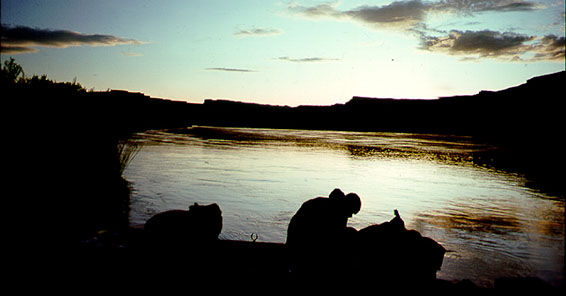
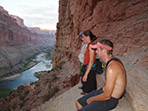
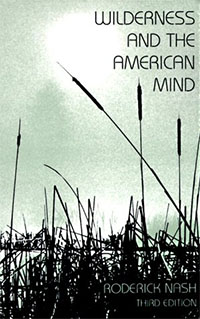 As the wilderness, however, was pushed back farther and farther, American attitudes about wild country began to change. In the scholarly work, Wilderness and the American Mind, Roderick Nash looked closely at American attitudes to wilderness. Nash observes that prior to the 1890's it was generally assumed that because the frontiersman was good, the wilderness, as his primary adversary, was bad—the villain of the national drama. But the growing perception that the frontier era was over prompted a reevaluation of the role of primitive conditions. Many Americans came to understand that wilderness was essential to pioneering: without wild country the concepts of frontier and pioneer were meaningless.
As the wilderness, however, was pushed back farther and farther, American attitudes about wild country began to change. In the scholarly work, Wilderness and the American Mind, Roderick Nash looked closely at American attitudes to wilderness. Nash observes that prior to the 1890's it was generally assumed that because the frontiersman was good, the wilderness, as his primary adversary, was bad—the villain of the national drama. But the growing perception that the frontier era was over prompted a reevaluation of the role of primitive conditions. Many Americans came to understand that wilderness was essential to pioneering: without wild country the concepts of frontier and pioneer were meaningless.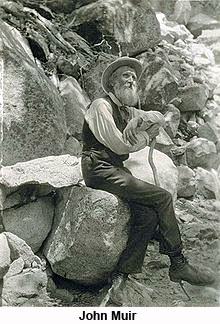 This gradual change in national attitude from one of an adversarial view of wilderness to one of a beneficial view, was slow in coming, but came. Key individuals—Henry David Thoreau, John Muir, Aldo Leopold, Robert Marshall, among others—wrote and spoke of this changed attitude. of these, probably no one expressed the value of wild country more fervently than John Muir, the founder of the Sierra Club. In the 1880's, Muir was the sounding board of the new climate. National strength no longer came from conquering the remnants of wilderness but from the enjoyment of the remaining wilderness. Like an ascetic, Muir went into the mountains with little more than the
clothes on his back and hard bread and returned to proclaim, "Climb the mountains and get their
good tidings. Nature's peace will flow into you as sunshine flows into trees. The winds will blow their own freshness into you, and the storms their energy, while cares will drop off like autumn leaves."
This gradual change in national attitude from one of an adversarial view of wilderness to one of a beneficial view, was slow in coming, but came. Key individuals—Henry David Thoreau, John Muir, Aldo Leopold, Robert Marshall, among others—wrote and spoke of this changed attitude. of these, probably no one expressed the value of wild country more fervently than John Muir, the founder of the Sierra Club. In the 1880's, Muir was the sounding board of the new climate. National strength no longer came from conquering the remnants of wilderness but from the enjoyment of the remaining wilderness. Like an ascetic, Muir went into the mountains with little more than the
clothes on his back and hard bread and returned to proclaim, "Climb the mountains and get their
good tidings. Nature's peace will flow into you as sunshine flows into trees. The winds will blow their own freshness into you, and the storms their energy, while cares will drop off like autumn leaves."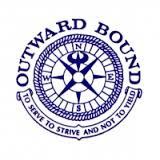 The American adaptation to the Hahn's Outward Bound was held in wilderness areas in Colorado, Oregon, Maine, North Carolina and Minnesota. Courses consisted of distance runs, swimming in icy streams and lakes, ascents of mountains, long backpack trips. Students learned skills in first aid, map and compass, rock and snow climbing techniques, survival tactics, outdoor cooking, shelter building and other skills. Courses also included solos where individuals were isolated in a remote location and spent three days alone with only a few camping items. Like Hahn's, the courses ended with the final expedition where a group of students orienteered across a wild area and ended at a designated place on the map.
The American adaptation to the Hahn's Outward Bound was held in wilderness areas in Colorado, Oregon, Maine, North Carolina and Minnesota. Courses consisted of distance runs, swimming in icy streams and lakes, ascents of mountains, long backpack trips. Students learned skills in first aid, map and compass, rock and snow climbing techniques, survival tactics, outdoor cooking, shelter building and other skills. Courses also included solos where individuals were isolated in a remote location and spent three days alone with only a few camping items. Like Hahn's, the courses ended with the final expedition where a group of students orienteered across a wild area and ended at a designated place on the map. 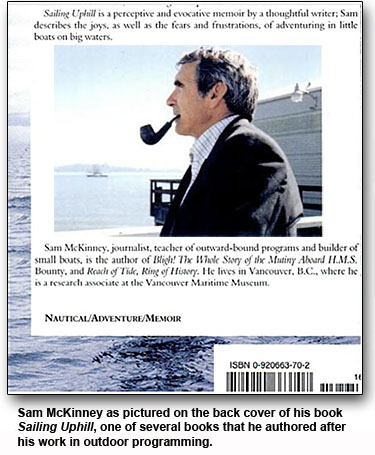 McKinney, who was the development officer at St. Helen's Hall, an Episcopal school in Portland, listened to a talk by Joshua Miner and became interested in the Outward Bound idea. Shortly after, the Northwest Outward Bound School opened in the summer of 1966.
McKinney, who was the development officer at St. Helen's Hall, an Episcopal school in Portland, listened to a talk by Joshua Miner and became interested in the Outward Bound idea. Shortly after, the Northwest Outward Bound School opened in the summer of 1966.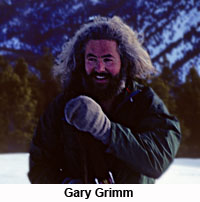 Among those in the audience enthralled with what McKinney was telling them were John Miles and Gary Grimm. Miles, who was working on post graduate work at the University of Oregon, had received his undergraduate degree from Dartmouth. A progeny of the Dartmouth Outing Club, Miles wanted to put together a program at University of Oregon that would provide greater opportunities than presently existed. Grimm, interested in the same, was involved in an increasingly frustrating and eventually unsuccessful pursuit of a doctorate's degree in outdoor recreation, which at the time did not exist at the University of Oregon. What Grimm, Miles and other friends eventually initiated at the university was a fairly simple system.
Among those in the audience enthralled with what McKinney was telling them were John Miles and Gary Grimm. Miles, who was working on post graduate work at the University of Oregon, had received his undergraduate degree from Dartmouth. A progeny of the Dartmouth Outing Club, Miles wanted to put together a program at University of Oregon that would provide greater opportunities than presently existed. Grimm, interested in the same, was involved in an increasingly frustrating and eventually unsuccessful pursuit of a doctorate's degree in outdoor recreation, which at the time did not exist at the University of Oregon. What Grimm, Miles and other friends eventually initiated at the university was a fairly simple system. 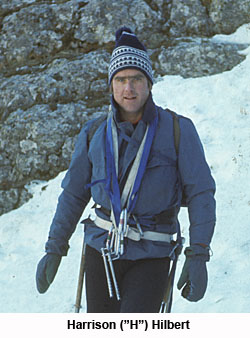 It was a memorable conference in the formative, innocent years of outdoor programming. Grimm remembers it as the ideal circumstances for outdoor program professionals to conduct a conference—outdoors with good companions and beautiful surroundings. The weather was crystal clear. Around the campfire stories of trips were told far into the evening. Miles remembers that at dawn, the group still awake and still deeply involved in conversation were captivated by the sunrise backlighting the looming figure of Mt. Baker in the east.
It was a memorable conference in the formative, innocent years of outdoor programming. Grimm remembers it as the ideal circumstances for outdoor program professionals to conduct a conference—outdoors with good companions and beautiful surroundings. The weather was crystal clear. Around the campfire stories of trips were told far into the evening. Miles remembers that at dawn, the group still awake and still deeply involved in conversation were captivated by the sunrise backlighting the looming figure of Mt. Baker in the east.